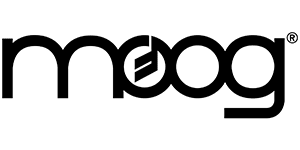
Moog Music is an American company based in Asheville, North Carolina which manufactures electronic musical instruments. The current Moog Music is the second company to trade under that name.
It was 1953 when Robert Arthur Moog together with his father founded a company for theremins production (electric musical instrument created by Léon Theremin/Lev Termen). Their company produced ready-made theremins as well as DIY kits which at that time costed $50 and by 1961 there had been more than 1000 kits sold.
In November 1963 in Rochester where a musical conference was held Robert Moog met Herbert Deutsch. And this occasion not only led to Moog company further development but also defined the image of modern synthesizers. Owing to Moog and Deutsch collaboration a nowaday synthesizer interface is presented with a keyboard and not a set of variable resistors.
The first Moog module prototype was created in 1964 and demonstrated at the Audio Engineering Society convention. Now this prototype is guarded by the walls of Henry Ford Museum in Detroit. "Jazz Images - A Worksong and Blues" composed by Herbert Deutsch was the first creation produced and performed using Moog synth.
In 1966 Robert Moog applied for a patent willing to put a name on its unique ladder (4-step) low pass filter. The patent №3475623 was issued in October 1969. 1v per octave and logarithmic scale came not long after.
In 1967 the company became known as R.A. Moog Inc. Module synthesizers I, II and III were let out under that brand name. Famous choreographer Alwin Nikolais was the first Moog synth buyer.
In 1968 Wendy Carlos released her album “Switched-On Bach” using only Moog module synthesizer. The album received three Grammy Awards and drew attention to the “moogs”. The Beatles and The Rolling Stones got in line to grab those module systems.
In 1970 Bill Waytena became an official owner of R.A. Moog Inc. Audio Engineering Society convention showed A Minimoog prototype that same year.
In 1971 R.A. Moog Inc. turns into Moog/Musonics and the company moves to Buffalo, New York. Specially for the Jazz in the Garden concerts held in The New York Museum of Contemporary Art four module systems 1CA were designed. Later Keith Emerson bought one of them and that’s how Emerson Moog Modular System got started.
In 1972 the company switches into Moog Music, Inc. Minimoog obtained its final structure being the 4 prototype and therefore adding “D” to the name.
In 1973 System 15, 35 и 55 were presented; Sonic Six designed by Bill Waytena; Satellite. Norlin Music corporation (also the owner of Gibson) took over Moog Music.
In 1975 Minitmoog and Taurus are released.
In 1977 Robert Moog leaves Moog Music, Inc.
In 1978 Multimoog appears on the shelves.
In 1979 Prodigy and Taurus II make their appearance.
In 1980 Moog Liberation keytar was created.
In 1981 the production of Minimoog synth was ceased – there were more than 12000 units sold. The analog Rogue and Moog Source with a microprocessor Z80 saw the light. Memorymoog was announced.
1982 was a big success for Memorymoog, but the company was still deep in crisis. Moog Music was sold in 1983. The year of 1983 divides Moog Music, Inc. into Moog Music and Moog Electronics, Inc.
In 1984 “Moog Producer” was made for Commodore 64 computer. The complex comprised MIDI support and software sequencer.
1986 led the brand to the bankruptcy.
RJE Reserch Corp. buys “Moog Music, Inc.” brand name and the rest of the Moog Electronics, Inc. assets in 1987.
In 2002 after Robert Moog had bought out “Moog” the new era began. A modern analog synthesizer Minimoog Voyager was created. In
2004 in the honour of 50th anniversary of Moog Music the expanded version Voyager Anniversary Edition was issued as well as Minimoog Voyager XL.
In 2006 “Phatty” surprised the music world and Little Phatty became first who did it. Moreover Little Phatty was the last synthesizer designed by Robert Arthur Moog himself (passed away on August 21 2005).
On April 1 2008 Moog Music announced about releasing a guitar. No one took it seriously but anyway later that same year they put up Moog Guitar for sale.
In 2014 the company started to produce a 37-note paraphonic analog SUB 37 – kind of a Phatty series successor. Moogfest 2014 showed Werkstatt 01 DIY kit. That year Moog Music went back to module system production. The first reissued synthesizer was Keith Emerson Modular System which costed $150 000.
In 2015 Model 15 (150 units priced at $1000), System 35 (35/22000) and System 55 (55/35000) were available as well being recreated manually. Model 15 emulator became the first official app for iOS and Mother 32 was announced in November as the first Eurorack Moog synthesizer.












